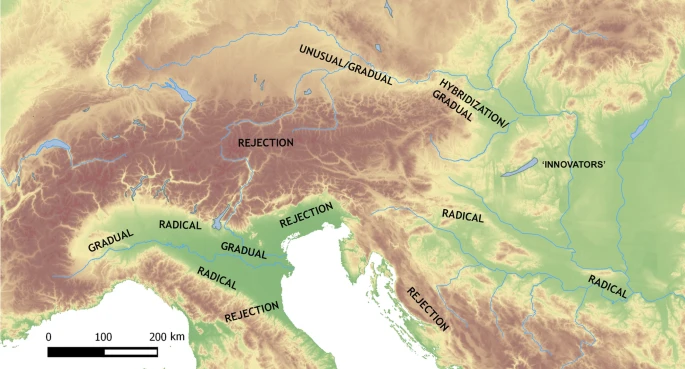Riverman you are trying to placate people, by giving each one as a good parent a toy, here some Illyrian for you, some Macedonian for Timmy, etc... but describing Albanians as some ancient creole population that belonged to no culture horizon is even more horrible outcome. And not a great explanation. Such populations with no real identity will not survive any migration crisis, and would more willingly assimilate into imperial identity. The creole explanation would better fit the Vlach/Romanians formation.
The Komani-Kruja culture of 600-900AD (compassing roughly from Montenegrin border to western lake Ohrid), is a urban culture, not pastoral like the early Albanian, people lived in fixed settlements. First inconsistency. Literary inscriptions found are in Latin, suggesting a Latin speaking population lived in this cultural horizan. There are Latin toponyms concentrated in this cultural horizon that are of Dalmatian/Illyrian Latin not Vulgar Latin, and for them to exists in today's Albanian would mean they were inherited from a pre-Albanian population which spoke Illyrian/Dalmatian Latin. We are not dealing here with a Albanian speaking population, and we have to identify who they were. All this points to J2b(with some R1b fellow travelers). Kruja-Komani and linguistic evidence strongly points to Albanian speech not being native to the area, it came from the speculated Nish-Shtip homeland.
To sum up the chronology, North Albania was a refuge area for Illyrians after the Slavic invasions. Later around 900 AD, early Albanians(E-V13 and R1b) settle in the core zone of this culture suppressing and pushing the J2b clades along the banks of Drin river. Around 1300 AD the two populations begin to merge as one(unify against Serbian pressure I assume), the process was finalized by Ottoman invasion (lots of destruction and shuffling of populations). To this day J2b is strongest among frontier Ghegs, recoiled like a serpent around Drin river and it's tributaries.
The people you are trying to placate are arguing linear decent from Bronze Age. If there was no DNA science they would argue times immemorial. They do think they evolved out of the rocks of their villages and when you point out inconsistencies they get offended and defensive, as if you are stealing something from them.
Nobody really knows at this point, but fact is that there was a wide stretch of land, and modern Albanians are directly in that zone, in which Proto-Illyrian J-L283 and the earlier groups (Thracian E-V13, Phrygian/Brygian R-Z2103 as the main haplogroups?) met. This means we have this mixture of linages minimum 1.000 years before the Antiquity Proto-Albanians were around. They surely assimilated people then too, like some Vlach lineages, some Roman, Greek, Slavic etc., but the basic, main lineages of E-V13, J-L283 and R-Z2103 are very likely to have been close by and intermixed before.
If you want to have E-V13 + R-Z2103 as the primary markers, you have to assume an origin from Thracians or Bryges. Basically, that's primarily a linguistic debate, because then you would have to prove a Thracian origin for Proto-Albanian, instead of an Illyrian one, which would connect with J-L283.
Fact is also that various people existed in the region, which united these groups, like the Srem group = Illyrians with Thracian substrate, Triballi = Thracians with Illyrian influences, Dardanians = Illyrians with Thracian substrate elements.
That alone is quite telling as to how long these people intermixed in the Central Balkans.



